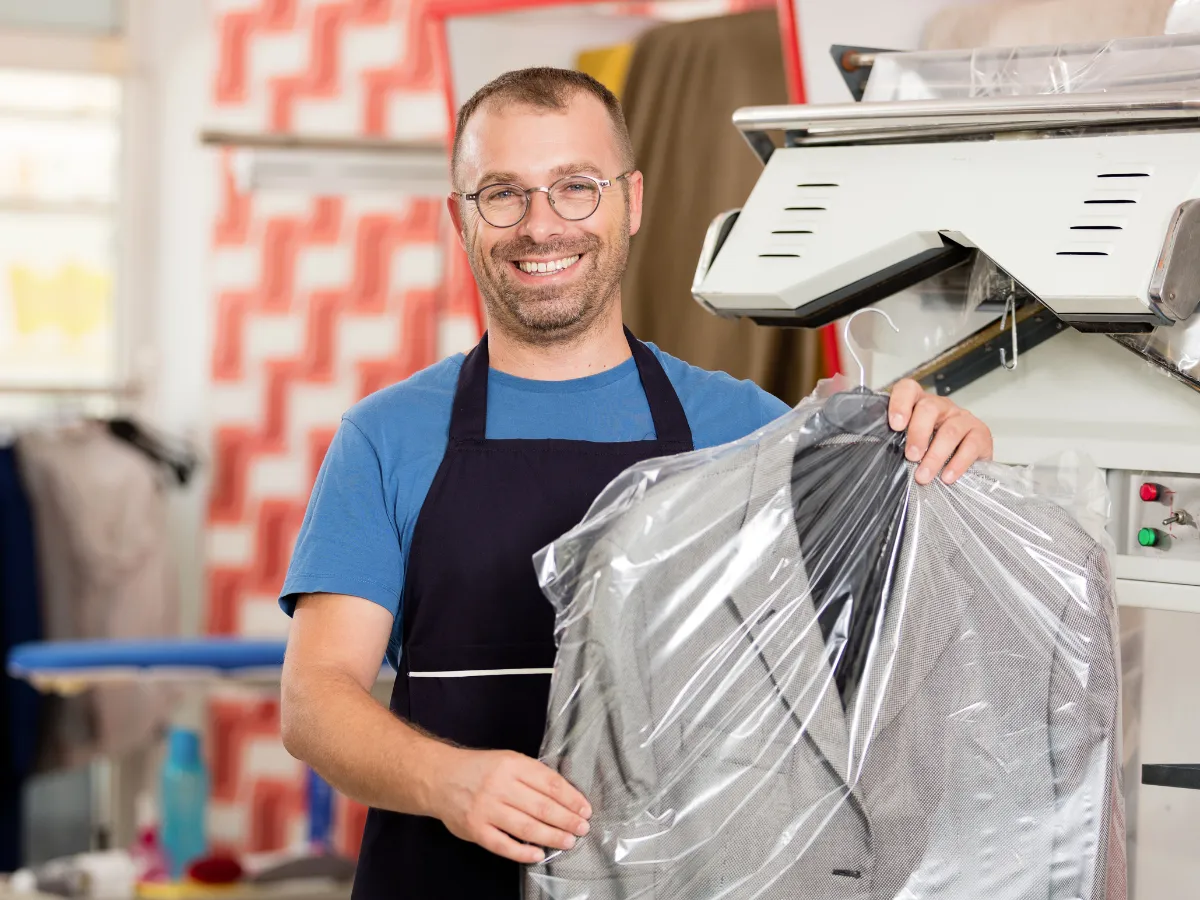Dry Cleaner or Home? How to "Dry" Clean a Jacket at Home

That impeccable suit jacket, the elegant wool coat, or that delicate blazer you only wear on special occasions... many of these garments carry the dreaded "Dry Clean Only" label. This often deters us from cleaning them, inevitably associating it with a visit (and expense) to the dry cleaner. But is it always necessary? Are there methods to dry clean a jacket at home safely and effectively?
The answer is yes, but with important caveats. It's crucial to understand that "home dry cleaning" does not replicate the chemical process of a professional dry cleaner. However, techniques and products exist that allow you to refresh, deodorize, and treat surface stains at home, extending the life of your jacket and spacing out visits to the professional. In this guide, we'll show you how to do it correctly.
First Things First: What Does "Dry Cleaning at Home" Mean?
It's essential to clarify this point. Professional dry cleaning uses specific chemical solvents and specialized machinery to remove dirt without using water. You can learn more about what dry cleaning is in our dedicated article.
When we talk about dry cleaning a jacket at home, we refer to methods that avoid fully immersing the garment in water and focus on:
- Surface cleaning: Removing dust, lint, and odors.
- Localized stain treatment: Acting only on the affected area.
- Using home kits: Employing products designed to refresh garments in a domestic dryer.
These methods are ideal for maintenance between professional cleanings or for handling minor mishaps, but they do not replace a deep clean if the jacket is very dirty or has tough stains.
Step Zero: The Label Rules (Always!)
We can't stress this enough: read the care label on your jacket. It's your primary guide.
- "Dry Clean Only": Maximum caution. Home methods must be very gentle and localized. Avoid excessive wetting.
- "Dry Clean Recommended": Indicates professional cleaning is best, but you might try gentle home methods more confidently (always testing first).
- Do Not Wash Symbol (Crossed-out Tub): Do not wash it with water.
- Hand Wash or Delicate Machine Wash Symbol: If present, you have more flexibility, although for structured jackets, surface cleaning is often preferable to maintain shape.
Correctly interpreting washing labels will save you from potential disasters.
When NOT to Attempt Cleaning at Home (Even "Dry" Methods)
There are situations where it's better not to take risks and go directly to a professional:
- Extremely Delicate Fabrics: Very fine silk, silk velvet, chiffon, garments with complex embroidery, fragile sequins, or glued beadwork.
- Leather and Suede: Require very specific products and techniques. Attempting to clean them at home without knowledge can cause permanent damage. Read our guide on how to wash leather jackets (which often involves specialized cleaning).
- Difficult or Large Stains: Oil, ink, red wine stains, or heavily set-in dirt probably won't come out with gentle home methods.
- Very Valuable or Sentimental Garments: If the jacket has significant monetary or sentimental value, don't risk it.
- Very Persistent Odors: Strong odors like dampness, mold, or smoke may require the professional deodorizing offered by dry cleaners.
Method 1: Refreshing and Dust Removal (Basic Maintenance)
Ideal for jackets that aren't stained but need freshening up.
- Brushing: Hang the jacket on a suitable hanger. Use a soft-bristled clothes brush and brush from top to bottom, following the fabric's grain. This removes dust, hair, and lint. Pay attention to the collar, shoulders, and lapels.
- Airing Out: Hang the jacket in a well-ventilated area (preferably outdoors, but out of direct sunlight) for a few hours. This helps eliminate accumulated odors (smoke, food...).
- Steaming (Optional): If you have a garment steamer, pass it gently a few inches away from the fabric (without touching). Steam helps relax fibers, remove light wrinkles, and neutralize odors. You can also hang it in the bathroom while taking a hot shower.

Method 2: Spot Cleaning Stains
For treating small, recent stains without wetting the entire garment.
- Identify the Stain: Is it grease, makeup, food? This can influence the product to use.
- Test in Hidden Area: ESSENTIAL. Apply a tiny amount of the product you plan to use on an inside hem or seam. Wait a few minutes and check that it doesn't discolor or damage the fabric.
- Prepare the Cleaning Solution:
- Mild Option (Ideal to start): Mix a few drops of very mild liquid detergent (pH neutral, for wool or delicates) in a bowl with cold water.
- Vinegar Option (For non-greasy stains): Mix equal parts white vinegar and cold water.
- Ammonia Option (Sweat/light grease stains, use with EXTREME caution): Dilute a VERY SMALL amount of ammonia (a few drops) in plenty of cold water. Wear gloves and ventilate well. Test absolutely necessary!
- Apply with a Cloth: Lightly dampen a clean white cloth with the chosen solution. Wring it out very well; it should be damp, not wet.
- Dabbing Technique: Gently press ("dab") the stain with the damp cloth. Start from the outer edges of the stain and work inward to avoid spreading it. DO NOT RUB. Switch to a clean area of the cloth as it picks up dirt.
- Localized "Rinse": Dampen another clean white cloth with only cold water, wring it out well, and gently press over the treated area to remove cleaning solution residue.
- Drying: Press the area with a clean, dry cloth to absorb maximum moisture. Let the jacket air dry completely, hanging on a hanger, in a ventilated place away from heat sources or direct sun.
If water rings remain after drying, it might be due to excess water or product. Try going over it again with a cloth barely damp with just water. For persistent stains, consider professional help before insisting too much. Sometimes stains leave yellow halos, which require a different type of treatment.
Method 3: Home Dry Cleaning Kits
These kits are a popular option for refreshing "Dry Clean Only" garments between visits to the dry cleaner.
- What's Included?: Usually, one or more wipes moistened with a cleaning/refreshing solution and a special reusable bag.
- How They Work: You place the jacket (few items at a time) and the wipe inside the bag. Seal the bag and put it in your home dryer on a low or medium heat cycle for the specified time (usually short, 15-30 min). The heat activates the solution on the wipe, releasing steam that penetrates the fibers, refreshing, removing light odors, and treating very light stains.
- Manufacturer's Instructions: It's VITAL to follow the specific instructions of the kit you purchase to the letter.
- Advantages: Convenient, quick, good for removing odors (smoke, food) and softening light wrinkles.
- Limitations: They do not perform a deep clean. Not very effective against set-in, old, or tough stains (grease, ink). They do not replace professional cleaning for real dirt. May leave a slight fragrance.
- Pre-treatment: Some kits include a small bottle of spot remover to apply to specific areas before putting in the bag.
They are a good option for maintaining suits, blazers, or coats that aren't visibly dirty but need "sprucing up".
Drying: A Critical Step After Cleaning
If you used any method involving moisture (spot cleaning), correct drying is essential:
- Always Air Dry: Immediately hang the jacket on a padded or wooden hanger that properly supports the shoulders.
- Good Ventilation: Choose an airy, dry location away from direct sunlight or heat sources (radiators, heaters).
- Patience: Let it dry completely. Trying to speed up the process with heat can damage the garment or set potential residues.
- Avoid the Dryer (Except for Kits): Never use a regular dryer for a jacket treated with wet methods, unless you are specifically using a home kit that requires it!
Frequently Asked Questions about Home Dry Cleaning
How do you dry clean a garment?
At home, it involves surface methods: brushing, airing, spot treating stains without much water, or using dryer kits. Professional dry cleaning uses chemical solvents in special machines.
How do you clean a jacket that cannot be dry cleaned?
If the label prohibits both water washing and dry cleaning, cleaning is very limited: brushing, airing, and extremely careful removal of very superficial stains with a barely damp cloth. Best to consult an expert.
How to clean a coat without taking it to the dry cleaner?
By brushing it, airing it out, carefully spot treating stains (cold water, mild detergent, no rubbing), or using a home cleaning kit to refresh it.
What product is used for dry cleaning?
Dry cleaners use solvents like perchloroethylene, hydrocarbons, or silicones. Home kits use mild cleaning solutions on wipes, not those solvents.
Cleaning a jacket "dry" at home is possible for keeping it fresh and treating minor accidents, provided it's done carefully and with an understanding of the limitations. For a deep clean or tough stains on delicate garments, the dry cleaner remains the safest and most effective option.
Need to Wash Bulky or Delicate Items?
While we don't offer professional dry cleaning, at LaColada Self-Service Laundry Ponferrada we have large-capacity washers and dryers, perfect for duvets, blankets, and other large items that can be washed with water. We also have delicate programs. If you have doubts about how to wash a specific garment, come visit us, and we'll advise you on the best options available in our facilities!
Visit LaColada in Ponferrada
Sebastián R.
More than 10 years at the helm of Lacolada Lavanderia Autoserivico Ponferrada and repairing industrial and domestic machinery in my spare time. You won't find unverified theories from the internet here, just real solutions tested by someone who gets their hands dirty every day.
Other Useful Cleaning Tips

How to Effectively Clean Carpets at Home
Tricks and methods to leave your carpets clean and fresh.

What is Professional Dry Cleaning?
Discover the real process and when it's essential.

How to Wash a Leather Jacket Correctly
Essential care for cleaning and maintaining leather garments.